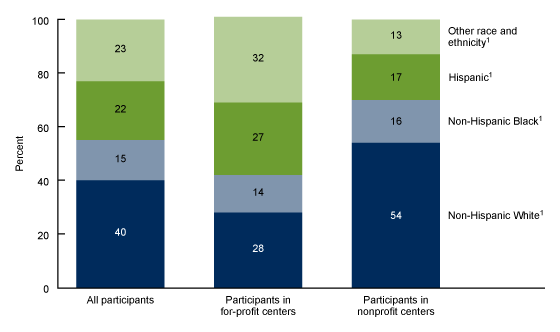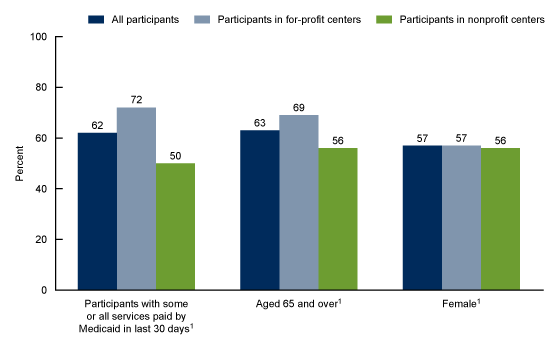Variation in Adult Day Services Center Participant Characteristics by Center Ownership: United States, 2020
NCHS Data Brief No. 453, December 2022
PDF Version (428 KB)
Priyanka Singh, M.P.H., Zhaohui Lu, M.S., and Manisha Sengupta, Ph.D.
- Key findings
- The racial and ethnic composition of participants in ADSCs varied by for-profit status.
- Selected sociodemographic characteristics of ADSC participants differed by center ownership.
- The prevalence of selected diagnosed medical conditions in ADSC participants differed by center ownership.
- Nonprofit ADSCs had a higher percentage of participants needing assistance with selected ADLs than for-profit centers.
- Summary
Data from the National Post-acute and Long-term Care Study
- A higher percentage of participants in nonprofit adult day services centers were non-Hispanic White (54%) compared with for-profit centers (28%).
- About 72% of participants in for-profit centers were Medicaid beneficiaries compared with 50% in nonprofit centers.
- The percentage of participants with Alzheimer disease or other dementias or with intellectual or developmental disability was higher in nonprofit centers than in for-profit centers.
- The percentage of participants needing assistance with bathing, dressing, toileting, and eating was higher in nonprofit centers than in for-profit centers.
An estimated 237,400 participants were enrolled in adult day services centers (ADSCs) in the United States in 2020 (1). Compared with users of other long-term care services, ADSC participants are younger and more racially and ethnically diverse (2). ADSC participants have a diverse set of needs, with many participants requiring assistance with activities of daily living (ADLs) and having chronic health conditions (3). This report presents the most current national estimates of selected characteristics of participants in ADSCs and compares these characteristics by center ownership type.
Keywords: medical conditions, activities of daily living (ADLs), home and community-based services, National Post-acute and Long-term Care Study
The racial and ethnic composition of participants in ADSCs varied by for-profit status.
- Non-Hispanic White (54%) and non-Hispanic Black (16%) people were more likely to be enrolled in nonprofit ADSCs compared with for-profit centers (28% and 14%, respectively). Conversely, Hispanic people (27%) and people of other races and ethnicities (32%) were more likely to be enrolled in for-profit centers compared with nonprofit centers (17% and 13%, respectively) (Figure 1).
Figure 1. Percent distribution of race and ethnicity among adult day services center participants, by center ownership: United States, 2020

1Differences between participants in for-profit and nonprofit centers are statistically significant, p < 0.05.
NOTE: Other race and ethnicity includes participants who are non-Hispanic American Indian or Alaska Native, non-Hispanic Asian, non-Hispanic Native Hawaiian or Other Pacific Islander, non-Hispanic of two or more races, other category not reported in the center’s system, or of unknown race and ethnicity. See “Data source and methods” in this report for details on the study and methodology. Percentages are based on unrounded numbers; estimates may not sum to totals because of rounding. Access data table for Figure 1.
SOURCE: National Center for Health Statistics, National Post-acute and Long-term Care Study, 2020.
Selected sociodemographic characteristics of ADSC participants differed by center ownership.
- A higher percentage of participants were Medicaid beneficiaries in for-profit centers (72%) compared with participants in nonprofit centers (50%) (Figure 2).
- A higher percentage of participants in for-profit ADSCs were aged 65 and over (69%) compared with nonprofit centers (56%).
- For-profit ADSCs had a slightly higher percentage of women participants (57%) compared with nonprofit centers (56%).
Figure 2. Selected sociodemographic characteristics among adult day services center participants, by center ownership: United States, 2020

1Differences between participants in for-profit and nonprofit centers are statistically significant, p < 0.05.
NOTES: Changes in wording in the 2020 Medicaid use item may have contributed to a difference in estimates from earlier surveys. See “Data source and methods” in this report for details on the study and methodology. Access data table for Figure 2.
SOURCE: National Center for Health Statistics, National Post-acute and Long-term Care Study, 2020.
The prevalence of selected diagnosed medical conditions in ADSC participants differed by center ownership.
- A higher percentage of participants in for-profit than in nonprofit centers had a diagnosis of diabetes (38% compared with 20%), depression (31% compared with 19%), heart disease (25% compared with 18%), or high blood pressure or hypertension (53% compared with 32%) (Figure 3).
- A lower percentage of participants in for-profit than in nonprofit centers had a diagnosis of Alzheimer disease or other dementias (21% compared with 29%) or intellectual or developmental disability (23% compared with 44%).
Figure 3. Selected diagnosed medical conditions in adult day services center participants, by center ownership: United States, 2020

1Differences between participants in for-profit and nonprofit centers are statistically significant, p < 0.05.
NOTES: Changes in wording in the 2020 heart disease item may have contributed to a difference in estimates from earlier surveys. Cases with missing data are excluded; missing data for all conditions ranged from 11.2% for Alzheimer disease or other dementias to 14.1% for heart disease. See “Data source and methods” in this report for details on the study and methodology. Access data table for Figure 3.
SOURCE: National Center for Health Statistics, National Post-acute and Long-term Care Study, 2020.
Nonprofit ADSCs had a higher percentage of participants needing assistance with selected ADLs than for-profit centers.
- Among all ADSCs, 37% of participants needed assistance with bathing, the most frequent functional limitation among participants, and 22% needed assistance with eating, the least common functional limitation among participants (Figure 4).
- A higher percentage of participants in nonprofit centers than in for-profit centers needed assistance with bathing (40% compared with 35%), dressing (36% compared with 32%), toileting (37% compared with 26%), and eating (26% compared with 19%).
Figure 4. Need for assistance with selected activities of daily living among adult day services center participants, by center ownership: United States, 2020

1Differences between participants in for-profit and nonprofit centers are statistically significant, p < 0.05.
NOTES: See “Data source and methods” in this report for details on the study and methodology. Access data table for Figure 4.
SOURCE: National Center for Health Statistics, National Post-acute and Long-term Care Study, 2020.
Summary
In 2020, U.S. ADSC participants differed by type of center ownership in a variety of characteristics examined in this report. As in previous years (4,5), the sociodemographic, functional and health status, and service use characteristics of center participants varied by type of center ownership. For-profit ADSCs had a higher percentage of people from racial and ethnic minority groups, served an older population (aged 65 and over), and had more participants that were Medicaid beneficiaries compared with nonprofit centers. For-profit centers served a higher percentage of participants with a diagnosis of diabetes, depression, heart disease, or high blood pressure or hypertension compared with nonprofit centers. Conversely, nonprofit ADSCs served a higher percentage of participants with a diagnosis of Alzheimer disease or other dementias and with intellectual or developmental disability. Nonprofit centers served more participants who needed assistance with selected ADLs.
This report presents the most current national estimates of selected characteristics of participants in ADSCs and compares these characteristics by center ownership. This report’s profile of ADSC participants provides information to policy makers, providers, researchers, and consumer advocates as they plan how best to meet the needs of an aging population.
Definitions
Adult day services center (ADSC): A community-based center, generally open on weekdays, that provides long-term care services, including structured activities, health monitoring, socialization, and assistance with ADLs to adults with disabilities.
Assistance with selected activities of daily living (ADLs): Refers to participants needing any help or supervision from another person or use of assistive devices, at their usual residence or at the ADSC, due to limitations in bathing, walking or locomotion, dressing, transferring in and out of a chair, toileting, or eating.
Heart disease: Includes conditions such as congestive heart failure, coronary or ischemic heart disease, heart attack, and stroke.
Medicaid beneficiary: Includes participants who had some or all of their long-term care services paid by Medicaid during the 30 days before the survey, including funding from a Medicaid state plan, Medicaid waiver, Medicaid managed care, or California regional center.
Other race and ethnicity: Includes participants of the following racial and ethnic backgrounds: non-Hispanic American Indian or Alaska Native, non-Hispanic Asian, non-Hispanic Native Hawaiian or Other Pacific Islander, non-Hispanic of two or more races, other category not reported in the ADSC’s system, and unknown race and ethnicity.
Ownership type: For-profit includes private for-profit centers, publicly traded centers, and limited liability centers. Nonprofit includes private nonprofit centers as well as federal, state, county, and local government-owned centers.
Data source and methods
Data are from the 2020 Adult Day Services Center Survey component of the biennial National Post-acute and Long-term Care Study (NPALS), conducted by the National Center for Health Statistics. The survey used a census of ADSCs in the National Adult Day Services Association’s database. More details on the NPALS survey, including eligibility criteria, design, and outcomes, are published elsewhere (1,6).
Although the 2020 NPALS includes an estimated 237,400 participants in 5,500 ADSCs nationwide, the analyses in this report are based on the 235,300 participants in ADSCs for which ownership status was known. Cases with missing data were excluded from the analyses, ranging from 1.1% for ownership status to 8.5% for the selected conditions. If the percentage missing was greater than 10%, it is noted in the data. Missing values for race, ethnicity, sex, and age were imputed.
Differences by ownership status were evaluated using t tests, and a ratio of weighted sums for each subgroup was computed for comparison. All statistical significance tests were two-sided, using p < 0.05 as the significance level. All differences reported are statistically significant unless otherwise indicated. Data analyses were performed using SAS version 9.4, SAS-callable SUDAAN version 11.0.4, and Stata/SE version 17.0.
About the authors
Priyanka Singh, Zhaohui Lu, and Manisha Sengupta are with the National Center for Health Statistics, Division of Health Care Statistics, Long-Term Care Statistics Branch.
References
- National Center for Health Statistics. 2020 National Post-acute and Long-term Care Study survey methodology for the Adult Day Services Center and Residential Care Community components. 2022.
- Lendon JP, Rome V, Sengupta M. Variations between adult day services centers in the
United States by the racial and ethnic case-mix of center participants. J Appl Gerontol 40(9):1029–38. 2021. - Sengupta M, Lendon JP, Caffrey C, Melekin A, Singh P. Post-acute and long-term care providers and services users in the United States, 2017–2018. National Center for Health Statistics. Vital Health Stat 3(47). 2022.
- Lendon JP, Singh P. Adult day services center participant characteristics: United States, 2018. NCHS Data Brief, no 411. Hyattsville, MD: National Center for Health Statistics. 2021.
- Lendon JP, Rome V. Variation in adult day services center participant characteristics, by center ownership: United States, 2016. NCHS Data Brief, no 296. Hyattsville, MD: National Center for Health Statistics. 2018.
- National Center for Health Statistics. 2020 National Post-acute and Long-term Care Study Adult Day Services Center (ADSC) restricted data file: Data description and usage. 2022.
Suggested citation
Singh P, Lu Z, Sengupta M. Variation in adult day services center participant characteristics by center ownership: United States, 2020. NCHS Data Brief, no 453. Hyattsville, MD: National Center for Health Statistics. 2022. DOI: https://dx.doi.org/10.15620/cdc:122046.
Copyright information
All material appearing in this report is in the public domain and may be reproduced or copied without permission; citation as to source, however, is appreciated.
National Center for Health Statistics
Brian C. Moyer, Ph.D., Director
Amy M. Branum, Ph.D., Associate Director for Science
Division of Health Care Statistics
Carol J. DeFrances, Ph.D., Acting Director
Alexander Strashny, Ph.D., Associate Director for Science